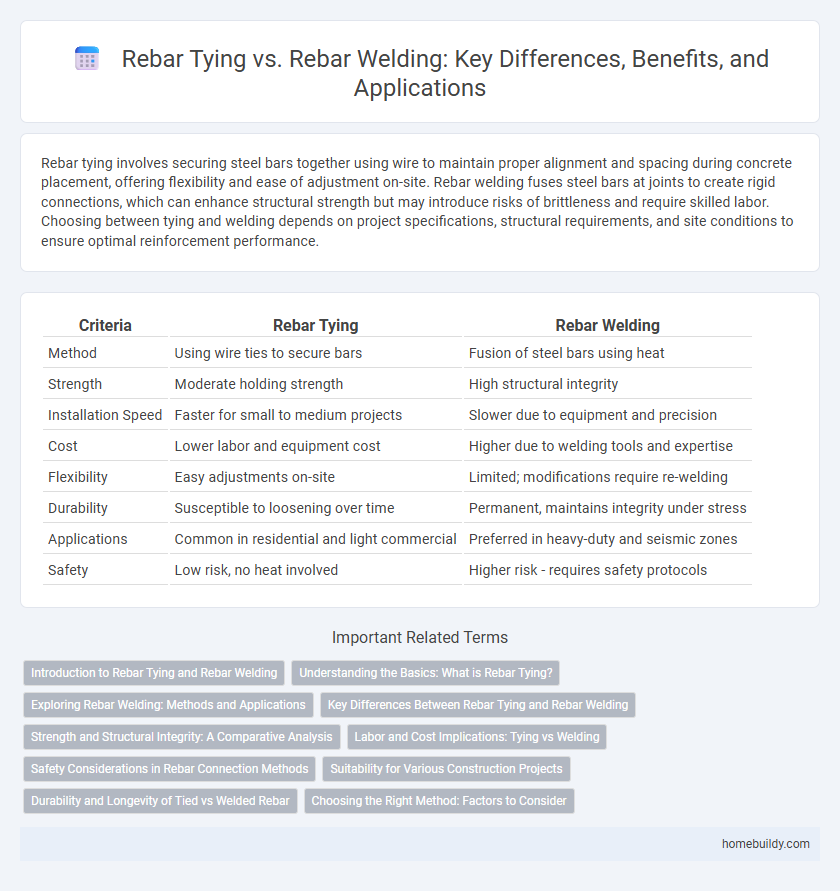Rebar tying involves securing steel bars together using wire to maintain proper alignment and spacing during concrete placement, offering flexibility and ease of adjustment on-site. Rebar welding fuses steel bars at joints to create rigid connections, which can enhance structural strength but may introduce risks of brittleness and require skilled labor. Choosing between tying and welding depends on project specifications, structural requirements, and site conditions to ensure optimal reinforcement performance.
Table of Comparison
| Criteria | Rebar Tying | Rebar Welding |
|---|---|---|
| Method | Using wire ties to secure bars | Fusion of steel bars using heat |
| Strength | Moderate holding strength | High structural integrity |
| Installation Speed | Faster for small to medium projects | Slower due to equipment and precision |
| Cost | Lower labor and equipment cost | Higher due to welding tools and expertise |
| Flexibility | Easy adjustments on-site | Limited; modifications require re-welding |
| Durability | Susceptible to loosening over time | Permanent, maintains integrity under stress |
| Applications | Common in residential and light commercial | Preferred in heavy-duty and seismic zones |
| Safety | Low risk, no heat involved | Higher risk - requires safety protocols |
Introduction to Rebar Tying and Rebar Welding
Rebar tying involves securing steel reinforcing bars with wire to maintain structural integrity during concrete pouring, ensuring proper alignment and spacing. In contrast, rebar welding joins bars by applying intense heat to fuse them, creating rigid connections for enhanced load-bearing capacity. Understanding these methods is essential for selecting appropriate techniques based on project requirements and structural performance.
Understanding the Basics: What is Rebar Tying?
Rebar tying involves securing steel reinforcing bars together using wire ties to maintain proper alignment and spacing within concrete structures. This method ensures structural stability and ease of adjustment during construction while avoiding the heat-affected zone risks associated with welding. Understanding rebar tying is essential for optimizing reinforcement placement and enhancing concrete durability in various building projects.
Exploring Rebar Welding: Methods and Applications
Rebar welding involves joining steel reinforcing bars using techniques like arc welding, resistance welding, or flash welding that create strong, rigid connections ideal for structural integrity in concrete construction. Common applications include precast concrete elements, heavy industrial projects, and high-stress zones where mechanical continuity is critical. Welding methods require strict adherence to safety standards and material compatibility to prevent weakening of the rebar and ensure long-term durability.
Key Differences Between Rebar Tying and Rebar Welding
Rebar tying involves securing steel bars with wire to maintain their position, offering flexibility and ease of adjustment on-site, while rebar welding fuses bars permanently using heat, creating a stronger and more rigid connection. Tied rebar joints allow for movement under stress, reducing the risk of cracks, whereas welded joints provide higher structural integrity but can introduce brittleness and susceptibility to rupture under certain conditions. The choice between tying and welding depends on factors such as load requirements, construction speed, and inspection protocols.
Strength and Structural Integrity: A Comparative Analysis
Rebar tying uses steel wire to fasten reinforcement bars, allowing flexibility and consistent load distribution, which enhances structural integrity under dynamic stress. In contrast, rebar welding fuses bars together, creating rigid joints with higher localized strength but potential weaknesses due to heat-affected zones and brittleness. Engineering standards often favor tying over welding in seismic zones because tied connections better accommodate stress and avoid brittle failure.
Labor and Cost Implications: Tying vs Welding
Rebar tying requires less specialized labor and generally incurs lower labor costs compared to welding, making it a cost-effective choice for many construction projects. Welding demands skilled technicians and more time, increasing overall labor expenses and project duration. The higher upfront cost of welding can be offset by its stronger joints in high-stress applications, but tying remains preferred for speed and budget efficiency.
Safety Considerations in Rebar Connection Methods
Rebar tying offers enhanced safety by minimizing heat exposure and reducing the risk of burns or fire hazards compared to rebar welding, which involves high temperatures and potential sparks. Tying also allows for easier adjustments and reduces the likelihood of structural weaknesses caused by improper welds or metal fatigue. Proper personal protective equipment (PPE) and adherence to safety protocols are critical in both methods to prevent injuries and ensure secure rebar connections.
Suitability for Various Construction Projects
Rebar tying is suitable for projects requiring flexibility and speed, such as residential buildings and light commercial structures, due to its ease of installation and adjustability. Rebar welding provides stronger, more rigid joints ideal for heavy-duty applications like bridges, high-rises, and industrial facilities where structural integrity is critical. Selecting between tying and welding depends on project scale, load requirements, and construction site conditions.
Durability and Longevity of Tied vs Welded Rebar
Tied rebar offers flexibility by allowing slight movement under load, reducing the risk of cracks and enhancing the durability of concrete structures. Welded rebar creates a rigid connection that may introduce stress concentrations, potentially leading to brittleness and premature failure if not executed correctly. The longevity of tied rebar systems generally surpasses welded ones, particularly in dynamic environments where structural resilience is critical.
Choosing the Right Method: Factors to Consider
Choosing between rebar tying and rebar welding depends on factors such as structural requirements, project scale, and environmental conditions. Rebar tying offers flexibility and ease for complex or irregular shapes, while welding provides stronger joint integrity but requires skilled labor and stricter safety measures. Cost, time constraints, and building codes also play critical roles in determining the most suitable reinforcement method for concrete structures.
Rebar Tying vs Rebar Welding Infographic

 homebuildy.com
homebuildy.com